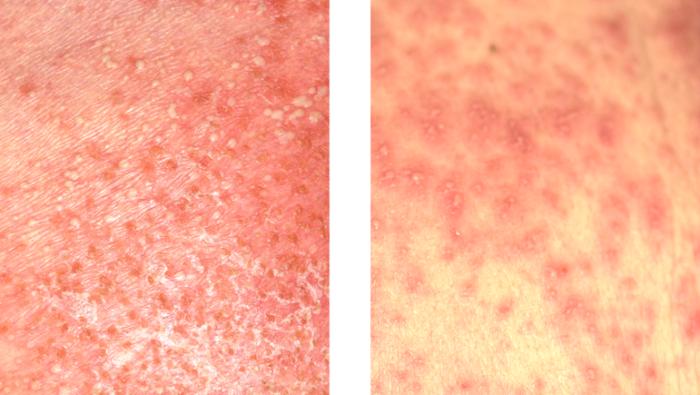Is it generalized pustular psoriasis (GPP) or acute generalized exanthematous pustulosis (AGEP)?
It can be hard for dermatologists to differentiate these two conditions as both have similar symptoms, but making the differential is important as prognosis and treatments differ. Without proper treatment, the symptoms can worsen severely and cause complications.
Researchers from Osaka Metropolitan University and the Mayo Clinic in Rochester, Minn. conducted a retrospective cohort study to compare the clinical and histopathologic features of GPP and AGEP in the United States and Japan and developed a disease prediction scoring system. The study included 54 people with GPP and 63 patients with AGEP.
The GPP group had more arthralgia, history of psoriasis or arthritis, family history of psoriasis or arthritis, malaise, psoriasiform plaques or patches, involvement of palms and soles, tenderness, and higher recurrence risk than their counterparts with AGEP. The GPP group also required more systemic treatment including oral acitretin or biologic agents. The AGEP group was more likely to report a causative drug, acute onset from drug administration, history of drug allergy, hemodynamic instability, itch, and lower extremity purpura.
The two diseases showed similar histopathologic and laboratory findings, however, neutrophils infiltrating the dermis were significantly denser in the GPP group. In addition, the GPP group had more plasma cells within the dermis. Serum alkaline phosphatase was the only laboratory value that was significantly higher in the GPP group, the study showed.
To provide algorithms designed to predict the disease, they established a scoring system for differentiating GPP from AGEP based on odds ratios calculated using data from 70% of the patients in the cohort. The scoring system was validated on data from 30% of patients in a cohort that was not used to create the scoring system. The scoring system had a sensitivity of 0.85, a specificity of 1.0, and an area under the curve value of 0.93.
“The results of this research might help medical professionals distinguish between GPP and AGEP, which have been difficult to differentiate in clinical practice. We hope the scoring system we suggest can lead to quicker diagnosis and the choosing of appropriate treatment,” says Dr. Mika Yamanaka-Takaichi of the Department of Dermatology at Osaka Metropolitan University’s Graduate School of Medicine in Osaka, Japan, in a news release. “In the future, we aim to establish a diagnostic index that clinicians can use practically to differentiate between the two diseases.”
Their findings were published in the Journal of the American Academy of Dermatology.
PHOTO CAPTION: A scoring system has been developed to help distinguish between two diseases.
Left: generalized pustular psoriasis (GPP). Right: acute generalized exanthematous pustulosis (AGEP).
PHOTO CREDIT: Osaka Metropolitan University


